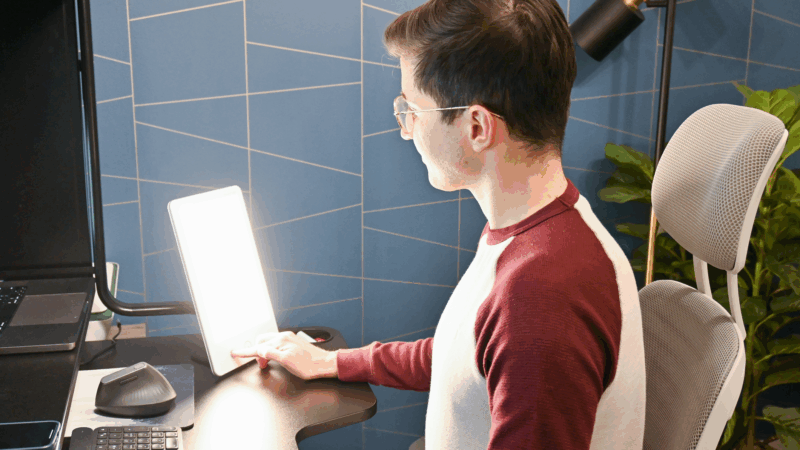Prone to winter depression? Starting light therapy now can help
Have you noticed you’re sleeping a little longer? Maybe you’re experiencing a shift in appetite — craving more sweets or pasta. In autumn, our bodies sense the change in light as the dark winter months approach, which can help explain what you are feeling.
As daylight diminishes, you may find your mood dimming, too. About 1 in 20 adults have Seasonal Affective Disorder — which is seasonal depression. And millions more experience a milder form of “winter blues.”
One way to fend it off is by using a light box, beginning in the fall.
“A lot of research has shown that using bright light therapy in the morning can be extremely helpful to reverse some of the symptoms of seasonal depression,” says Dr. Dorothy Sit, a psychiatrist and Associate Professor at Northwestern University, who has studied bright light therapy.
Typically, people sit in front of a light box, which emits bright light, every morning, for about 30 minutes, give or take. Sit says making it part of a morning routine is key. “If people use a light box every day they can experience an enduring effect throughout the fall and winter,” she says.
Sit points to an often-cited study that found light therapy is on par with standard anti-depression medications in relieving symptoms. Some people do both, taking medication and using a light box, and research shows the combination can be helpful. Studies point to improvements in symptoms within one week of starting light therapy.
Understanding our body clocks
Our bodies can be quite sensitive to changes in daylight because we rely on it to regulate our circadian rhythms and our sleep-wake patterns.
And because our internal body clocks don’t keep a perfect 24-hour cycle, the master clock in our brains needs a daily reset. “Light through the eyes,” is the cue for the reset, explains Michael Terman, a retired professor of clinical psychology and psychiatry at Columbia University.
That’s why exposure to morning light is so important. “What we are doing is resetting that drifting circadian clock to synchronize with the outdoor world,” Terman explains.
Terman is also President of the non-profit organization, Center for Environmental Therapeutics, which aims to educate healthcare professionals and the public about therapies to improve mood and health, focusing on non-medication treatments, including light boxes.
Terman says some models of light boxes sold online are either too small or don’t emit enough bright light. His organization offers guidance on how to select a light box, and recommends purchasing models that meet the standards of devices tested in clinical trials.
A few things to keep in mind when starting use of a light box:
- Purchase a light box that emits 10,000 lux of light. (Lux is a measure of brightness.)
- Larger screens are better, according to the Center for Environmental Therapeutics, because screen size influences light exposure.”Smaller sizes increase the likelihood that small head movements reduce the 10,000 lux dose,” the group says.
- Adjust the angle of the light box. The light box should project downwards towards the eyes at an angle. This will help avoid a glare.
- Start with 30 minutes in front of the light box and make adjustments based on how you feel. If you only get a little spurt of additional energy, you may want to increase to 45 minutes. Or if you feel jittery, that may be too much. “Just as with a drug, light has to be dosed,” Terman says.
“I think bright light is still an underrecognized treatment option,” says psychiatrist Dorothy Sit. And you don’t need to be clinically depressed to benefit. Light therapy can be quite helpful for people who even have “milder forms,” she says.
So, If you’re one of the many people who feels a dip in mood and energy beginning in fall, you may want to consider a light box, Sit says. But she also recommends that you talk to a healthcare provider about symptoms and treatment options.
Also, keep in mind that a lack of light is not the only trigger of a low mood. If it’s cold and snowy, people tend to go out less, says Dr. Jamie Zeitzer of Stanford University. “That can be depressing.” He says light therapy won’t help with the blues caused by social isolation, so remember to reach out to friends and stay engaged in activities that bring you into contact with others.
When it comes to feeling good in the coming darker months, we need light, as well as a handful of habits that can help boost our moods, including laughter, friendship, a healthy diet, physical activity and exercise.
Jeffrey R. Holland, next in line to lead Church of Jesus Christ of Latter-day Saints, dies at 85
Jeffrey R. Holland led the Quorum of the Twelve Apostles, a key governing body. He was next in line to become the church's president.
Winter storm brings heavy snow and ice to busy holiday travel weekend
A powerful winter storm is impacting parts of the U.S. with major snowfall, ice, and below zero wind chills. The conditions are disrupting holiday travel and could last through next week.
Disability rights advocate Bob Kafka dead at 79
Bob Kafka was an organizer with ADAPT (American Disabled for Attendant Programs Today), a group which advocates for policy change to support people with disabilities.
‘It’s behind you!’ How Britain goes wild for pantomimes during the holidays
Pantomimes are plays based on a well-known story — often a fairy tale — which are given a bawdy twist. The audience is expected to join in throughout, shouting as loudly as they can.
Kennedy Center vows to sue musician who canceled performance over Trump name change
The Kennedy Center is planning legal action after jazz musician Chuck Redd canceled an annual holiday concert. Redd pulled out after President Trump's name appeared on the building.
Our top global photo stories from 2025: Fearless women, solo polar bear, healing soups
These stunning photos include a polar bear in a Chinese zoo, a teen in Zambia facing an uncertain future, Mongolian kids watching TV in a tent, a chef prepping a bowl of good-for-you soup.







